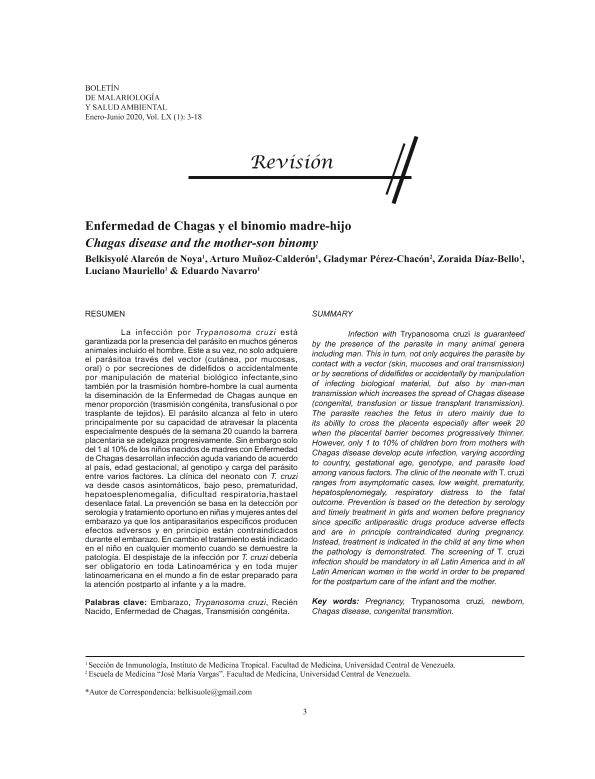Mostrar el registro sencillo del ítem
dc.contributor.author
Alarcón de Noya, Belkisyolé

dc.contributor.author
Muñoz Calderon, Arturo Alejandro

dc.contributor.author
Perez Chacon, Gladymar
dc.contributor.author
Diaz Bello, Zoraida
dc.contributor.author
Mauriello, Luciano
dc.contributor.author
Navarro, Eduardo
dc.date.available
2024-03-14T15:33:43Z
dc.date.issued
2020-01
dc.identifier.citation
Alarcón de Noya, Belkisyolé; Muñoz Calderon, Arturo Alejandro; Perez Chacon, Gladymar; Diaz Bello, Zoraida; Mauriello, Luciano; et al.; Enfermedad de Chagas y el binomio madre-hijo; Inst Altos Estudios; Boletin de Malariologia y Salud Ambiental; LX; 1; 1-2020; 1-16
dc.identifier.issn
1690-4648
dc.identifier.uri
http://hdl.handle.net/11336/230598
dc.description.abstract
La infección por Trypanosoma cruzi está garantizada por la presencia del parásito en muchos géneros animales incluido el hombre. Este a su vez, no solo adquiere el parásitoa través del vector (cutánea, por mucosas, oral) o por secreciones de didelfidos o accidentalmente por manipulación de material biológico infectante,sino también por la trasmisión hombre-hombre la cual aumenta la diseminación de la Enfermedad de Chagas aunque en menor proporción (trasmisión congénita, transfusional o por trasplante de tejidos). El parásito alcanza al feto in utero principalmente por su capacidad de atravesar la placenta especialmente después de la semana 20 cuando la barrera placentaria se adelgaza progresivamente. Sin embargo solo del 1 al 10% de los niños nacidos de madres con Enfermedad de Chagas desarrollan infección aguda variando de acuerdo al país, edad gestacional, al genotipo y carga del parásito entre varios factores. La clínica del neonato con T. cruzi va desde casos asintomáticos, bajo peso, prematuridad, hepatoesplenomegalia, dificultad respiratoria,hastael desenlace fatal. La prevención se basa en la detección por serología y tratamiento oportuno en niñas y mujeres antes del embarazo ya que los antiparasitarios específicos producen efectos adversos y en principio están contraindicados durante el embarazo. En cambio el tratamiento está indicado en el niño en cualquier momento cuando se demuestre la patología. El despistaje de la infección por T. cruzi debería ser obligatorio en toda Latinoamérica y en toda mujer latinoamericana en el mundo a fin de estar preparado para la atención postparto al infante y a la madre.
dc.description.abstract
Infection with Trypanosoma cruzi is guaranteed by the presence of the parasite in many animal genera including man. This in turn, not only acquires the parasite by contact with a vector (skin, mucoses and oral transmission) or by secretions of didelfides or accidentally by manipulation of infecting biological material, but also by man-man transmission which increases the spread of Chagas disease (congenital, transfusion or tissue transplant transmission). The parasite reaches the fetus in utero mainly due to its ability to cross the placenta especially after week 20 when the placental barrier becomes progressively thinner. However, only 1 to 10% of children born from mothers with Chagas disease develop acute infection, varying according to country, gestational age, genotype, and parasite load among various factors. The clinic of the neonate with T. cruzi ranges from asymptomatic cases, low weight, prematurity, hepatosplenomegaly, respiratory distress to the fatal outcome. Prevention is based on the detection by serology and timely treatment in girls and women before pregnancy since specific antiparasitic drugs produce adverse effects and are in principle contraindicated during pregnancy. Instead, treatment is indicated in the child at any time when the pathology is demonstrated. The screening of T. cruzi infection should be mandatory in all Latin America and in all Latin American women in the world in order to be prepared for the postpartum care of the infant and the mother.
dc.format
application/pdf
dc.language.iso
spa
dc.publisher
Inst Altos Estudios

dc.rights
info:eu-repo/semantics/openAccess
dc.rights.uri
https://creativecommons.org/licenses/by-nc-sa/2.5/ar/
dc.subject
Embarazo
dc.subject
Trypanosoma cruzi
dc.subject
Transmision congenita
dc.subject
Enfermedad de Chagas
dc.subject.classification
Otras Medicina Clínica

dc.subject.classification
Medicina Clínica

dc.subject.classification
CIENCIAS MÉDICAS Y DE LA SALUD

dc.title
Enfermedad de Chagas y el binomio madre-hijo
dc.title
Chagas disease and the mother-son binomy
dc.type
info:eu-repo/semantics/article
dc.type
info:ar-repo/semantics/artículo
dc.type
info:eu-repo/semantics/publishedVersion
dc.date.updated
2024-03-14T09:55:12Z
dc.journal.volume
LX
dc.journal.number
1
dc.journal.pagination
1-16
dc.journal.pais
Venezuela

dc.description.fil
Fil: Alarcón de Noya, Belkisyolé. Universidad Central de Venezuela; Venezuela
dc.description.fil
Fil: Muñoz Calderon, Arturo Alejandro. Universidad Central de Venezuela; Venezuela. Consejo Nacional de Investigaciones Científicas y Técnicas; Argentina
dc.description.fil
Fil: Perez Chacon, Gladymar. Universidad Central de Venezuela; Venezuela
dc.description.fil
Fil: Diaz Bello, Zoraida. Universidad Central de Venezuela; Venezuela
dc.description.fil
Fil: Mauriello, Luciano. Universidad Central de Venezuela; Venezuela
dc.description.fil
Fil: Navarro, Eduardo. Universidad Central de Venezuela; Venezuela
dc.journal.title
Boletin de Malariologia y Salud Ambiental

Archivos asociados
